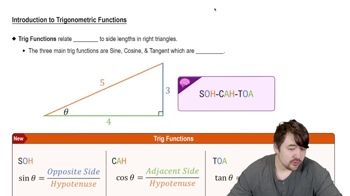Table of contents
- 0. Functions7h 52m
- Introduction to Functions16m
- Piecewise Functions10m
- Properties of Functions9m
- Common Functions1h 8m
- Transformations5m
- Combining Functions27m
- Exponent rules32m
- Exponential Functions28m
- Logarithmic Functions24m
- Properties of Logarithms34m
- Exponential & Logarithmic Equations35m
- Introduction to Trigonometric Functions38m
- Graphs of Trigonometric Functions44m
- Trigonometric Identities47m
- Inverse Trigonometric Functions48m
- 1. Limits and Continuity2h 2m
- 2. Intro to Derivatives1h 33m
- 3. Techniques of Differentiation3h 18m
- 4. Applications of Derivatives2h 38m
- 5. Graphical Applications of Derivatives6h 2m
- 6. Derivatives of Inverse, Exponential, & Logarithmic Functions2h 37m
- 7. Antiderivatives & Indefinite Integrals1h 26m
- 8. Definite Integrals4h 44m
- 9. Graphical Applications of Integrals2h 27m
- 10. Physics Applications of Integrals 2h 22m
3. Techniques of Differentiation
The Chain Rule
Problem 3.7.108b
Textbook Question
The Chain Rule for second derivatives
b. Use the formula in part (a) to calculate .
 Verified step by step guidance
Verified step by step guidance1
Step 1: Identify the function and its inner function. Here, the outer function is \( \sin(u) \) and the inner function is \( u = 3x^4 + 5x^2 + 2 \).
Step 2: Compute the first derivative using the chain rule. The derivative of \( \sin(u) \) with respect to \( u \) is \( \cos(u) \), and the derivative of \( u \) with respect to \( x \) is \( 12x^3 + 10x \). Therefore, the first derivative is \( \frac{d}{dx} \left( \sin(u) \right) = \cos(u) \cdot (12x^3 + 10x) \).
Step 3: Apply the product rule to differentiate the first derivative. The first derivative is a product of two functions: \( \cos(u) \) and \( 12x^3 + 10x \). Use the product rule: \( (fg)' = f'g + fg' \).
Step 4: Differentiate \( \cos(u) \) with respect to \( x \) using the chain rule. The derivative of \( \cos(u) \) is \( -\sin(u) \cdot (12x^3 + 10x) \).
Step 5: Differentiate \( 12x^3 + 10x \) with respect to \( x \), which is \( 36x^2 + 10 \). Combine these results using the product rule to find the second derivative.
 Verified video answer for a similar problem:
Verified video answer for a similar problem:This video solution was recommended by our tutors as helpful for the problem above
Video duration:
4mPlay a video:
Was this helpful?
Key Concepts
Here are the essential concepts you must grasp in order to answer the question correctly.
Chain Rule
The Chain Rule is a fundamental theorem in calculus used to differentiate composite functions. It states that if a function y is composed of two functions u and x, then the derivative of y with respect to x can be found by multiplying the derivative of y with respect to u by the derivative of u with respect to x. This rule is essential for calculating derivatives of functions that are nested within one another.
Recommended video:

Intro to the Chain Rule
Second Derivative
The second derivative of a function is the derivative of the derivative, providing information about the curvature of the function's graph. It indicates how the rate of change of the function is itself changing. In practical terms, the second derivative can reveal whether a function is concave up or concave down, which is useful for understanding the behavior of the function and identifying points of inflection.
Recommended video:

The Second Derivative Test: Finding Local Extrema
Trigonometric Functions
Trigonometric functions, such as sine, cosine, and tangent, are fundamental in calculus, especially when dealing with periodic phenomena. The sine function, in particular, is crucial when applying the Chain Rule, as it often appears in composite functions. Understanding the properties and derivatives of trigonometric functions is essential for solving problems involving their rates of change and for applying rules like the Chain Rule effectively.
Recommended video:

Introduction to Trigonometric Functions

 5:02m
5:02mWatch next
Master Intro to the Chain Rule with a bite sized video explanation from Callie
Start learningRelated Videos
Related Practice






